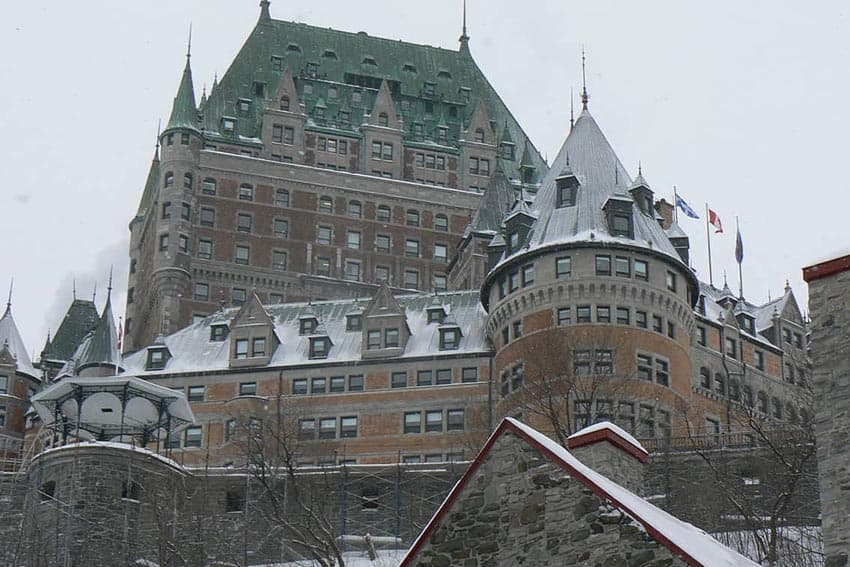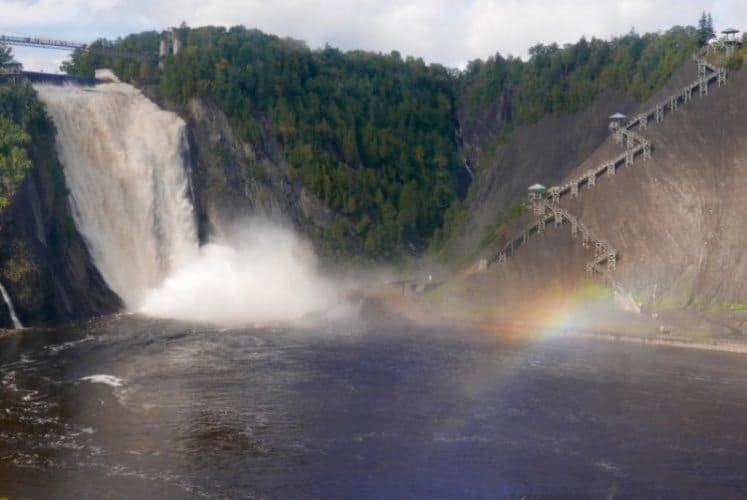
Recreational Cycling At Its Best in Quebec
By Wendy Hammerle
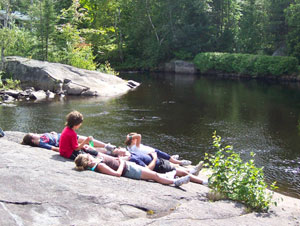
Sitting next to the rushing water, with the sun on our faces and our bikes propped up against a tree, I thought about how it just doesn’t get much better than this:
Cycling from inn to inn through the longest linear park in Canada, a perfect mix of fresh air and exercise, little villages, friendly people, and amazing food.
The nice lady from the tourist bureau in Quebec had assured me on the phone that we could easily handle biking 50 kilometers (31 miles) a day on the famed P’tit Train du Nord Linear Park bikeway.
I thought she must be referring to all those Lance Armstrong wannabes decked out in yellow dry weaves and black spandex.
Me, I’m a recreational cyclist. I wear tee-shirts and shorts. I like to putz along, look at the scenery and stick my toes in any cool bodies of water that might intersect with the trail.
A Little Leery
So I was a little leery about having to do all those kilometers just to get to our next night’s lodging. But the lure of this trail, winding through mountain lakes, rivers, and woods and dotted with small European-style inns and bed and breakfasts, was too strong to pass up.
Built on an abandoned rail bed, Le P’tit Train du Nord stretches 200 kilometers (124 miles) from its northern point at Mont-Laurier down to Saint-Jerome, about 45 minutes north of Montreal. This is known as the Laurentian region of the province of Quebec and is a popular vacation area for cross-country skiers and snowmobilers in the winter and cyclists in the summer.

We drove our car to Saint-Jerome and parked (for free) in a big lot right next to the trail’s southern end. Then our bikes were loaded onto a trailer and we hopped into the shuttle bus for a two-hour ride north. (Transport du Parc Lineaire “Domaine Marie-Max“)
The best part about planning a bike trip on Le P’tit Train du Nord is that the friendly folks in the Laurentide Tourist Bureau (1-800-561-6673) do everything for you.
Just call them ahead of time, tell them how many kilometers/miles you want to cover each day, whether or not you want your baggage transported and what kind of accommodations you prefer – small hotel, inn or bed & breakfast. Then they actually book everything for you at no charge.
Wimping out a bit, we had decided to start our ride at the 145k (90 mi) mark in a little town called Nominingue. Our hotel, the Auberge Villa Bellerive, was wedged neatly between the trail and a good-sized lake. This historic hotel and restaurant is a family-run business and is in such a safe area that our room didn’t need a key!
Arriving at dinnertime, we ate in their little Cafe du Quai overlooking Lake Nomininque (the Maudite beer from Quebec and the grilled honey mustard chicken sandwich were excellent) then retired early to get ready for our next day’s ride. Had we more energy, we could have taken a dip in the pool, the lake or the hot tub.
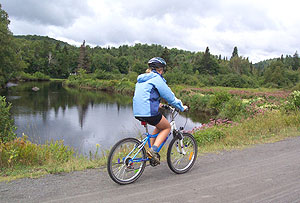
The Famous Scenery
The next morning, we had to get our suitcase out to the front desk by 9:00 so the transport van could take it to our next hotel. The service we used charged $12 per segment (all prices listed here are in Canadian dollars.) Many cyclists opt to carry their gear on their bikes in panniers (think saddlebags.)
Soon after hitting the trail that morning, we had our first taste of the famous scenery – evergreen forests with clumps of birch, fern carpets and cerulean skies; million-dollar lake views and a tangle of brooks and rivers weaving their way through the mountains.
The rivers in this area, including the aptly named Riviere Rouge, are a deep rust color from the iron ore in the soil. At about the 136-kilometer mark, look for beaver dams just a few feet from the bike path.
After a full morning of riding, we rolled into the Gare de Labelle (106k), an old train station now housing an information center, sandwich shop, and small (free) museum. Train buffs shouldn’t miss the museum with its photos of old train plows pushing walls of snow off the tracks. This station, festive with its international flags and dozens of bicyclists milling about, is a great place to refill your water bottles, grab something to eat and use the restrooms.
There are stations with services all along the bikeway and we found them to be clean and the staff very helpful. You can also buy your trail pass at these stations. The pass for bicycles, required from May to October, is $5/day or $15/season, children under 17 are free.

Labelle is also the point at which the trail turns from pavement to crushed stone. This will slow you down a bit and you’ll have to watch for sandy patches, especially near road crossings.
A Musical Mecca
At about 97k (60 mi), you’ll pass Les Jardins de L’Achillee Millefeuille, an organic Bed and Breakfast right on the trail. As we rode by, the soothing sound of Simon and Garfunkel drew us into this Mecca in the middle of the woods.
They feature a health-food restaurant/bar, organic gardens, messages, an Indian teepee, and camping for cyclists.
Our next night’s lodging was in Mont Tremblant (91k). The approach to the village takes you around Lac Mercier, with the water literally lapping up against the side of the bike path. There are several small hotels right on the trail. We stayed in the historic Hotel Mont Tremblant. Spotless and reasonably priced, it has views of the lake and access to the beach.
After a refreshing dip in the lake, we took a five-minute bus ride ($1.25) to the huge new Tremblant Resort. Somewhat Disneyesque, it’s a planned village of shops, hotels, restaurants, and golf courses covering the whole side of a mountain. On the August evening we visited, it was filled with tourists shopping, eating and taking gondola rides; in the winter it attracts skiers.
We opted to eat back at our hotel’s restaurant called Le Bernadin. Both the food and service were exceptional (try the veal scaloppini, salad, and coffee for $25) and it has a large terrace, so you can dine inside or out, even for breakfast.

Dusted By Young and Old
Our next day’s ride was mostly uphill, but it was a long, gradual slope. After more than an hour of climbing, a very fit woman, looking to be in her 70s, peddled up behind us and blew right past us. Her “Bay Area Senior Cyclists” tee-shirt spoke volumes.
The truth is, we got left in the dust by most riders, young and old. Biking is obviously very popular in this area, and most people appeared to be in good shape.
We saw many families bicycling together including a young father and his 12-year old son, who were doing the whole 200k (124 mi) ride in two days!
We were happy with our own progress on the up-grade, reaching our third night’s stop in Saint-Agathe at 49k (30 mi), by early afternoon. Ste-Agathe is another charming little town on a mountain lake. We stayed at the beautifully decorated Auberge du Lac des Sables, about 1.5 kilometers (0.9 mi)from the bike path.
This small hotel has a big deck with a hot tub overlooking the water, a restaurant and the rights to a very nice beach across the street. After a swim, we walked into the village and dined al fresco at Le Petite Allemagne (I recommend the salmon with dill sauce, wild rice and vegetables for $15.95 Canadian.) Back at the hotel, you can have a drink on the deck and watch the sun slip down behind the lake.
Working Up An Appetite

The next morning after a generous breakfast at the hotel we made our way back to the bikeway and one of the prettiest sections of the trail.
It’s here, just south of Ste-Agathe, that the trail hugs the Riviere du Nord, which alternates between roaring rapids and slow, languid stretches. Have your camera ready.
At 42k (26 mi), you hit Val David, a quaint, artsy town that happened to be hosting a large pottery exhibition when we visited. After browsing a bit, we grabbed some lunch at Le Grand Pa, known for its wood-fired pizza.
We sat outside on the big sunny porch and feasted on linguine with eggplant, red peppers, mushrooms and olives baked in a cruet with melted cheese on top and served with fresh bread. Did I mention that biking makes you hungry?
It was also in Val David, that we stumbled on the La Maison de Baviere, a small ‘gite touristique’ that will definitely be on my itinerary if we ever return. This cozy Bavarian inn sits right on some waterfalls and is a favorite spot for cross-country skiers in the winter.
Back on the trail we stopped at 39k (24 mi) for a snooze on a huge flat rock that juts out into the river. Then it was on to our next destination, Auberge La Bruyere in Saint-Adele. Located at 33k (20 mi), the hotel was only half a kilometer 0.3 mi) off the bikeway, but there was no sign for it on the trail and we had a little trouble finding it.
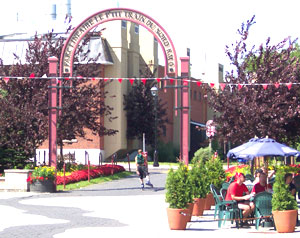
Once there, however, the auberge owner made us feel at home. We relaxed by the pool before dining at the hotel’s restaurant. The owner was a chef for many years before buying the hotel and the meal reflected his talents. (I recommend the chicken citron $16.95)
A Riot of Wildflowers
Our final day of biking from Ste-Adele to the finish line at Saint-Jerome went by too quickly. Mostly downhill, this section of the trail was bordered by a riot of wildflowers and offered more enticing river views. By noon we sailed under the arches at Ste-Jerome, Tour de France style.
The nicely designed park at the trail’s end includes walk-through water fountains, a snack bar and Vert Cafe Bistro, which served terrific ciabatta sandwiches. The old rail station and some train cars also house a tourist information center and a luggage transport office.
Filled with cyclists and rollerbladers, the atmosphere here is exciting and you feel a sense of accomplishment and an instant connection to these perfect strangers. Even without yellow jerseys, we completed our 145k (90 mi) trip on Le P’tit Train du Nord in four days with plenty of time to spare, proving after all, that the nice lady at the tourist bureau knows her stuff.

Wendy Hammerle is a former television news reporter/anchor and TV commercial writer and producer. She now works as a Public Relations Director and is a member of the Manhan Rail Trail Committee in Easthampton, Massachusetts, where she lives with her husband and children.
Eurail Passes: What to Know about Buying a Europe Train Pass
- The Wild Mississippi: 2340 Miles Across Ten States - April 8, 2024
- Exploring the Floating Villages of Tonle’ Sap Lake - April 3, 2024
- Woman Traveling Solo on Turkish Buses - March 27, 2024





